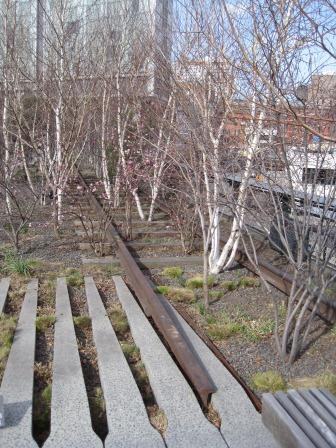I spent the last few days in New Jersey, with a quick day trip into NYC. It was a perfect East Coast winter day – sunny and cold – while back home in Seattle it rained. So it was with real joy that I hoofed it through some of the city’s greenspaces, ending up at The High Line.
I won’t go into detail about the site’s history and development of this city landscape, because the link will do that much better and with more authority than I can. But briefly, the High Line was the elevated freight train line used in the industrial district. After it was decommissioned, it was developed into a public greenspace. And an important note – it is entirely funded through private money. Its future won’t be affected by city budget cuts.

I was enchanted by the landscaping: it looks like an abandoned trainyard that’s being taken over by a re-emerging forest. Rather than being centered in a planting space, most of the trees and shrubs pop up right next to a rail or crossbeam; dead grasses remain in place, and you can see crocus and other spring flowers poking through. It’s obviously a designed space, but it’s not unnatural.

There are benches everywhere – some big enough for two people to sunbathe. There’s an outdoor movie projector across from a white-painted wall for showing movies in the summer; bleachers are built against the opposite wall. It’s an interesting, inviting, and unique landscape, allowing you see the city from a completely different perspective.

Sorry, this comment isn’t directly related to this post but I am wondering if any of you have written about or done a post on zeolite? I have Linda and Jeff’s books but it is not discussed in any of them. It is touted as removing toxins and it is supposed to have a particular affinity for holding ammonia which means it could be used for remediation of toxic soils and possibly make nitrogen fertilizer more effective. But this is all on the websites selling it so I am reluctant to trust the information. Also, people are supplementing with it claiming it cures cancer!? Anyways, if you have written about it and could direct me to the post I would appreciate it. Or if you could write a post about it that would be cool as well! I am currently trying to decide if it’s worth my money.
Thanks.
I was in NY in early November last year and was besotted with The High Line. I simply loved it. I loved the huge concrete columns laid flat as a paving system. It blended so well with the old bits of railway line they retained in the design. Always running in the direction of foot traffic, they guide you along a walk that is teeming with plants. It’s design is beautifully executed. Considering the ingenuity involved in both its design and construction, could it be NY’s horticultural Guggenheim? A must to visit if you’re in NY!
What is zeolite? Could you explain please?
Zeolites are porous, natural compounds consisting of aluminum and silica. Their common uses include cat litter, aquaria filters, water purification, and as cation exchange compounds in soils. Lots of different types, lots of different applications.